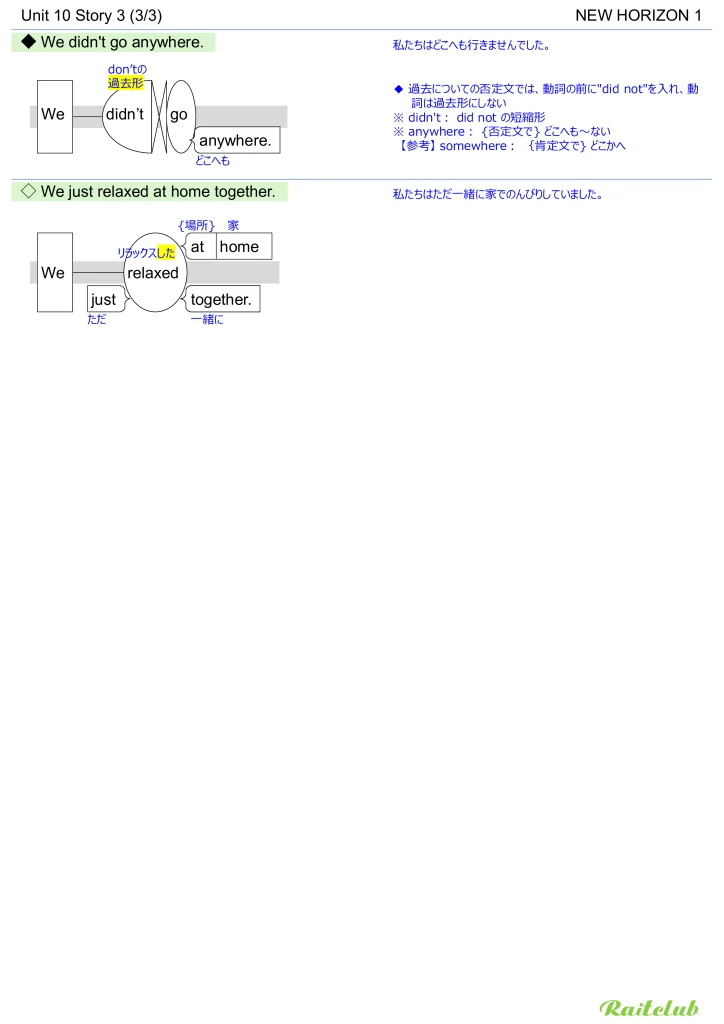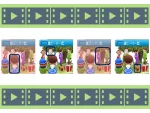中学1年生教科書 New Horizon 1 (ニューホライズン 1年) Unit 10: Winter Vacation の重要文法と、本文・和訳・英文見える化チャートです。
英文見える化チャートは、英語の「意味理解」を視覚的にサポートするツールです。習得を促進する音声付きです。音読活動などで活用することで英語を身に着けるのを支援します。
ポイント解説付きなので、定期テスト対策として、単語の意味・用法や、文法・文構造の確認にも使えます。
なおこのページでは英語のみの音声も聞けます。リスニングやシャドウイングなどでお使いいただけます。
重要文法
【・・・しました。】 一般動詞の過去形(“…ed”)
➡ He played soccer.
問:Did he play soccer? 答:Yes, he did. [No, he did not.]
否:He did not play soccer.
/d/ (travel) traveled; (stay) stayed
/t/ (look) looked; (watch) watched
/ɪd/ (visit) visited; (need) needed
“ied” (try) tried; (study) studied
【・・・しました。】 一般動詞の過去形(不規則)
➡ I ate curry.
問:Did you eat curry? 答:Yes, I did. [No, I did not.]
否:I did not eat curry.
Ex. (do) did; (take) took; (get) got; (have) had; (make) made; (come) came; (say) said; (feel) felt; (bring) brought; (spend) spent
本文・和訳・チャート
音声リスト
※ バックグラウンド再生もできます
以下の各パート内の音声は速度調整や個別にループ再生もできます
Unit 10 Story 1
◆ I traveled to London with my friend during winter vacation.
私は冬休みの間に、私の友達と、ロンドンへ旅行しました。
◆ 動詞を “…ed” の形にすると、「…しました」の意味になる {過去形}
“ed” の発音は /d/
travel → traveled
◇ We stayed there for a week.
私たちはそこで1週間滞在しました。
◆ On the afternoon of December 31, we visited the British Museum.
12月31日の午後に、私たちは大英博物館を訪れました。
◆ visit → visited
“ed” の発音は /ɪd/ ← /t/か/d/で終わる動詞
※ on ~: ~[日付や曜日] に
on May 5, on Sunday, on Monday night
参考)in ~: ~[朝・午後、月など時間帯・期間] に
in the afternoon, in July, in winter
at ~: ~[時刻] に
at three o’clock, at noon
◆ We looked around the museum for three hours.
私たちは3時間、その博物館を見て回りました。
◆ look → looked
“ed” の発音は /t/ ← /k/や/tʃ/など無声子音で終わる動詞
※ |look around| ~: ~を見て回る
◇ It is full of interesting things.
それは興味深いものでいっぱいです。
※ of ~: {材料・中身} ~で(作られた)、~の(入った)
◇ In the evening, we watched a musical at a theater.
晩に、私たちは劇場でミュージカルを見ました。
※ in ~: ~[朝・午後・晩、月、季節、年など時間帯・期間] に
※ evening: {日没から寝るまでの夜の早い時間帯} 晩、夜
◇ My favorite actor played a leading part.
私の好きな俳優が主役を演じました。
◇ We listened to some wonderful songs and enjoyed the performance very much.
私たちはいくつかの素晴らしい歌を聴き、その公演をとても楽しみました。
※ listen to ~: ~を聴く
音声(英語/習得用)
| ♪ 英語の音声: | |
| 1回再生 | |
|---|---|
| ループ再生 | |
| ♪ 習得用の音声(英⇒日を区切りごと): | |
| 1回再生 | |
|---|---|
| ループ再生 | |
英文見える化チャート 1/2
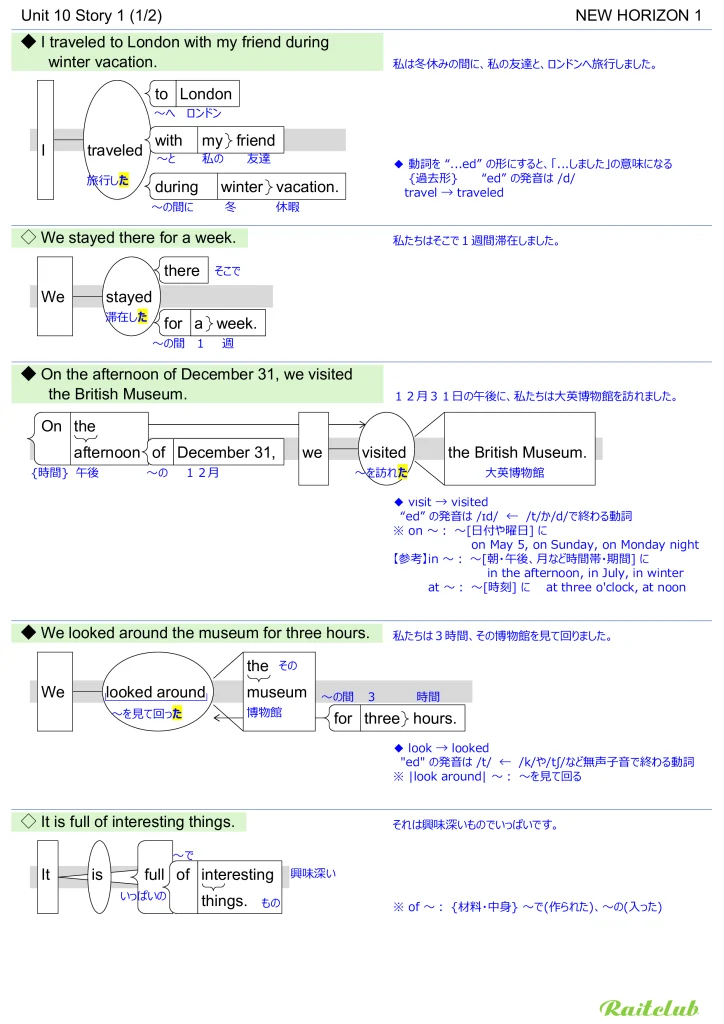
英文見える化チャート 2/2
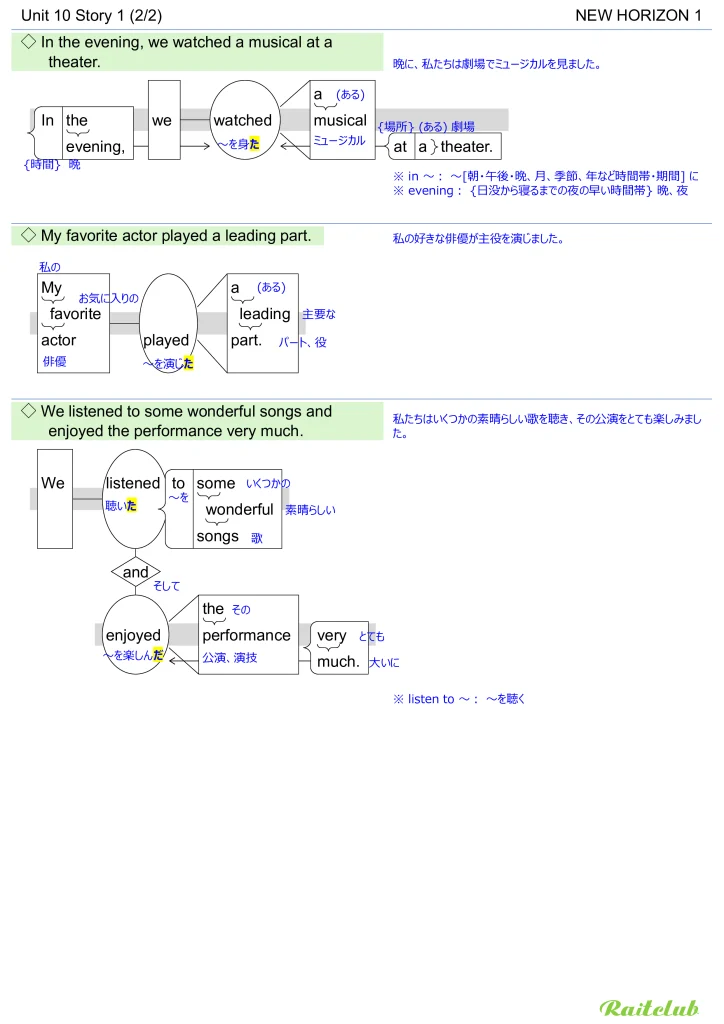
Unit 10 Story 2
◆ My friend and I spent the night near Big Ben, a famous clock tower.
私の友達と私は、有名な時計塔のビッグ・ベンの近くでその夜を過ごしました。
◆ 過去形が “…ed” の形でない動詞もある(不規則に変化)
◆ spent: spend の過去形
◆ We took “the Tube,” London’s subway, to Westminster Station.
私たちはウェストミンスター駅まで、ロンドンの地下鉄の「チューブ」を利用しました。
◆ took: take の過去形
※ take ~: ~[交通手段] を利用する、に乗る; ~を選ぶ;
~[休み等の活動]をとる;
◇ We ate fish and chips, and walked around.
私たちはフィッシュ・アンド・チップスを食べ、あちこちを歩きました。
※ ate: eat の過去形
◆ Many people came and stood near the clock tower.
多くの人がその時計塔の近くに来て立ちました。
◆ came: come の過去形
◆ stood: stand の過去形
◇ We all counted down to the New Year together.
私たちみんなは、一緒に新年に向けて数を逆に数えました(カウントダウンをしました)。
※ all: 全て、全員(代名詞)
we all: 私たちみんなは you all, they allも同様
= all of us all of you, all of them
※ down: 下方へ; 量が少ない方へ
⇔ up
◆ At midnight, we saw some great fireworks.
真夜中に、私たちはいくつかのすごい花火を見ました。
※ at ~: ~[時刻、時刻名] に at 7:30, at sunset
※ saw: see の過去形
◆ People said, “Happy New Year!” to each other.
人々はお互いに対し「ハッピー・ニュー・イヤー!」と言いました。
◆ said: say の過去形
※ say ~: ~と言う ~が引用句の場合は say, “~” と書く
※ each other: お互い(代名詞) 主語では使わない
※ each ~: それぞれの~
◆ I felt so happy.
私はとてもうれしく感じました。
※ felt: feel の過去形
◇ We had a wonderful time.
私たちは素晴らしい時を過ごしました。
※ had: have の過去形
※ have ~: {経験} ~を経験する、~を過ごす; ~を食べる;
{所有、所持} ~を持つ、~がある; ~[病気、症状]がある
音声(英語/習得用)
| ♪ 英語の音声: | |
| 1回再生 | |
|---|---|
| ループ再生 | |
| ♪ 習得用の音声(英⇒日を区切りごと): | |
| 1回再生 | |
|---|---|
| ループ再生 | |
英文見える化チャート 1/2
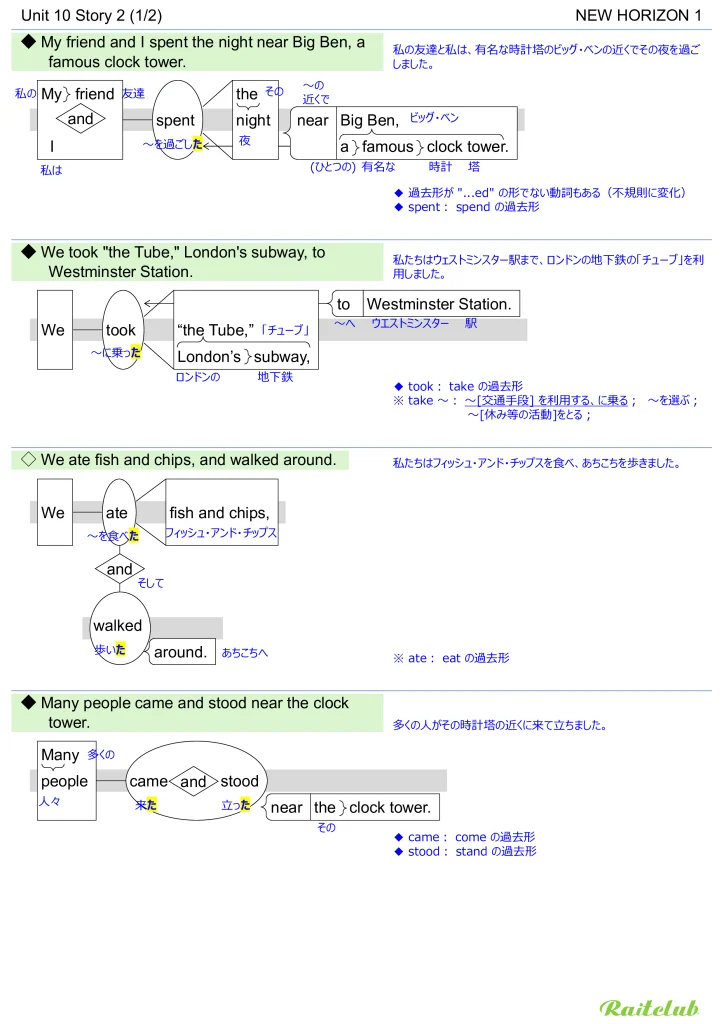
英文見える化チャート 2/2
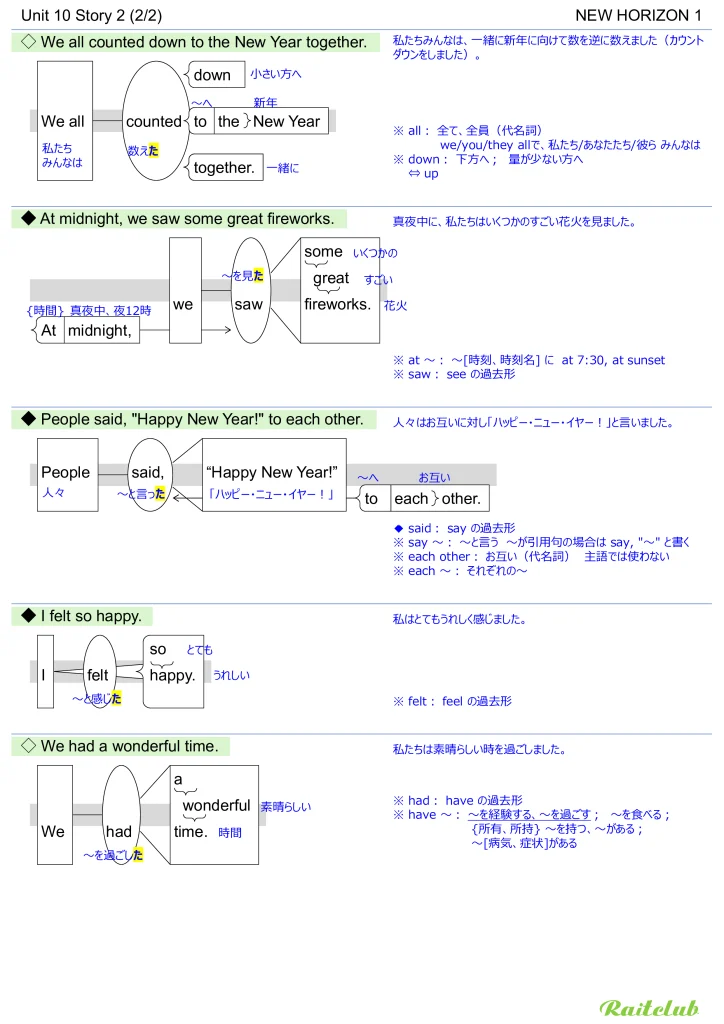
Unit 10 Story 3
◆ What did you do on New Year’s Day?
あなたは元旦に何をしましたか。
◆ 過去についての疑問文では、主語の前に”did”を置き、動詞は過去形にしない
did: 疑問文や否定文を作る do (助動詞)の過去形
◇ I got up early and went to a shrine with my family.
私は早く起きて、私の家族と神社へ行きました。
◆ got: get の過去形
※ |get up|: 起床する
※ went: go の過去形
◇ That’s nice.
それはいいですね。
◆ Did you eat any traditional New Year’s food?
あなたたちは伝統的な新年の料理を何か食べましたか。
※ any: {疑問文で} 何らかの(1つでも)、いくらかの
参考)some: {肯定文で} いくらかの
◆ Yes, we did.
はい、食べました。
◇ We ate osechi.
私たちはおせちを食べました。
◆ Did you and your parents make it?
あなたとあなたの両親がそれを作りましたか。
◆ No, we didn’t.
いいえ、作りませんでした。
◇ Kaito’s mother made some and brought it to us.
かいとのお母さんがいくらか作り、それを私たちの所に持ってきました。
◆ made: make の過去形
※ brought: bring の過去形
◇ How nice!
なんてすばらしい!
※ “How + 形容詞か副詞 + ! ” で、「なんて~だろう!」と感動を表す
◇ How about you?
あなたはどうですか。
◇ What did you do?
あなたは何をしましたか。
◇ Nothing special.
特に何も。
※ nothing: (無いもの) → 何も~ない、無、ゼロ
修飾するには、形容詞を後ろに置く
something, anythingも同様 例:something cold
◆ We didn’t go anywhere.
私たちはどこへも行きませんでした。
◆ 過去についての否定文では、動詞の前に”did not”を入れ、動詞は過去形にしない
※ didn’t: did not の短縮形
※ anywhere: {否定文で} どこへも~ない
参考)somewhere: {肯定文で} どこかへ
◇ We just relaxed at home together.
私たちはただ一緒に家でのんびりしていました。
音声(英語/習得用)
| ♪ 英語の音声: | |
| 1回再生 | |
|---|---|
| ループ再生 | |
| ♪ 習得用の音声(英⇒日を区切りごと): | |
| 1回再生 | |
|---|---|
| ループ再生 | |
英文見える化チャート 1/3
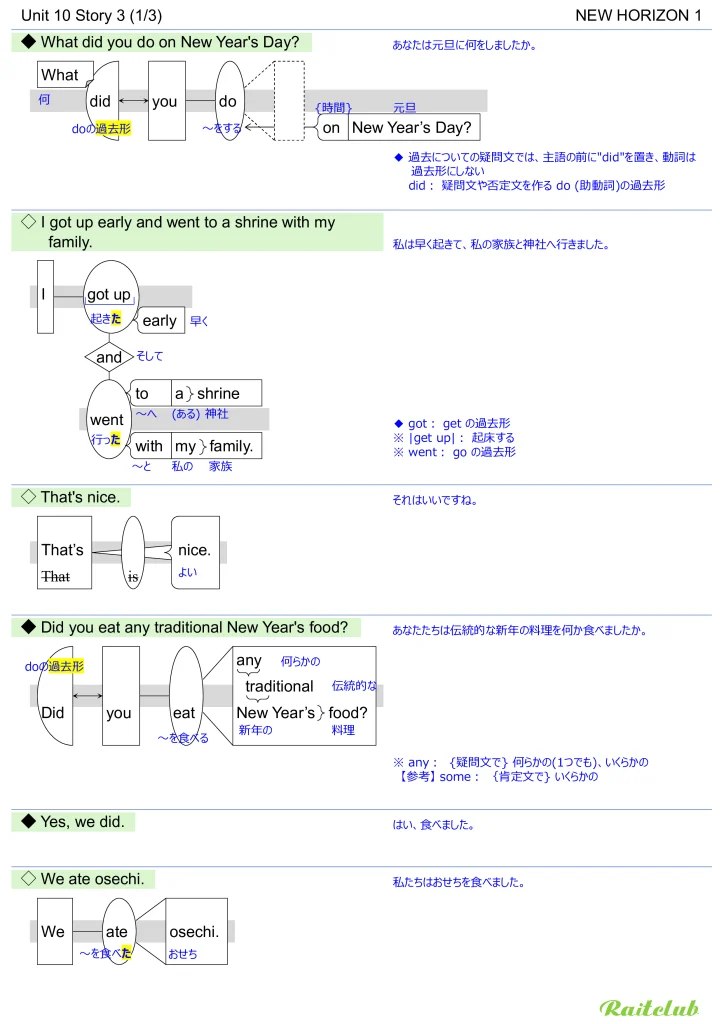
英文見える化チャート 2/3
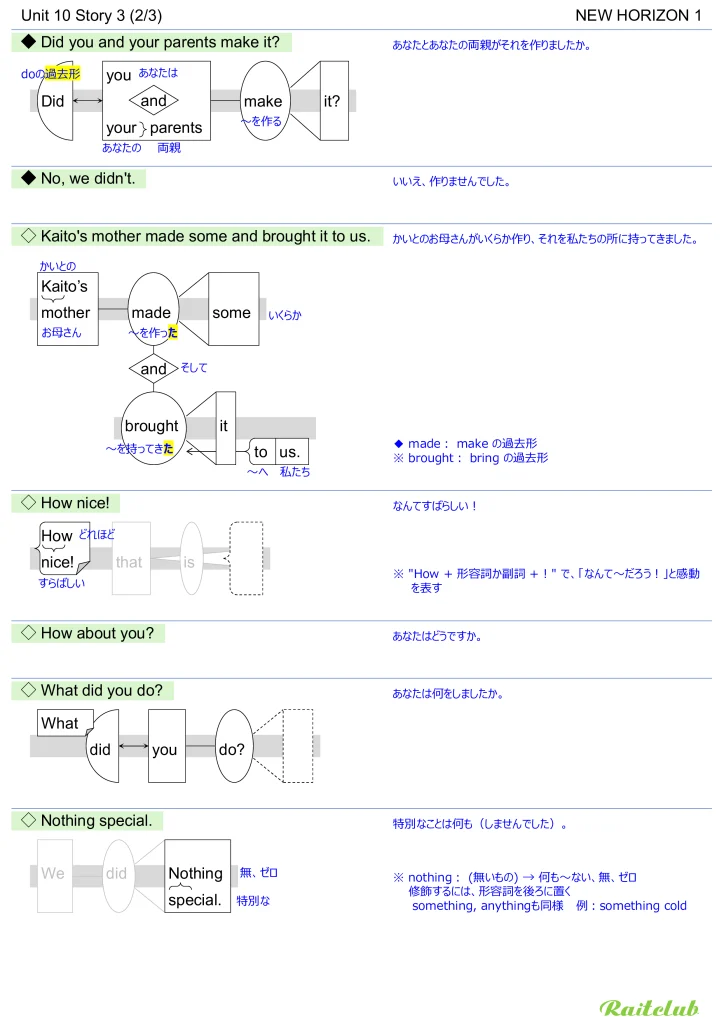
英文見える化チャート 3/3
